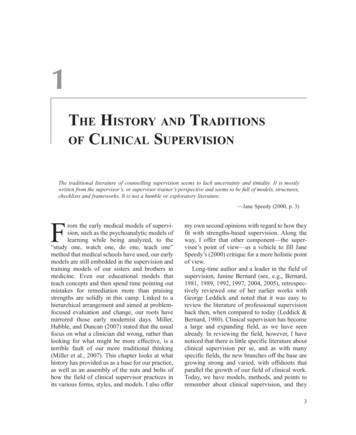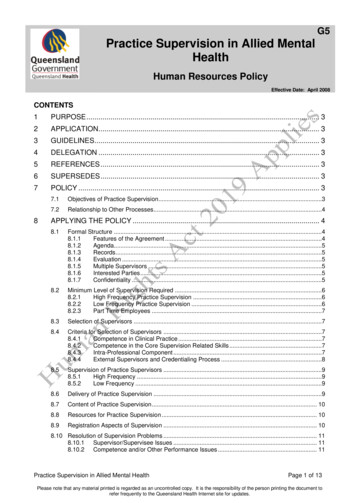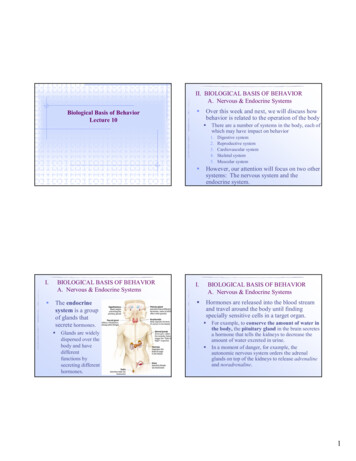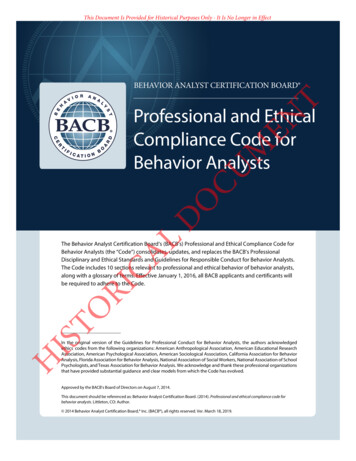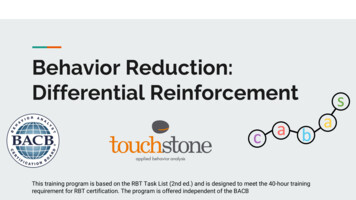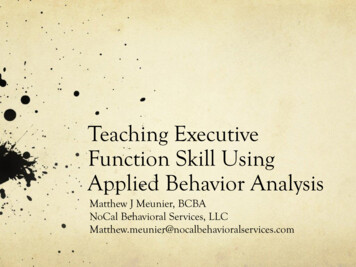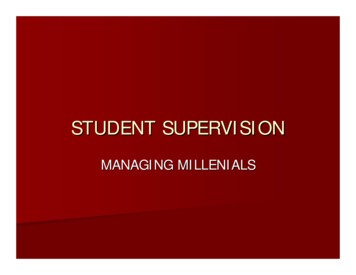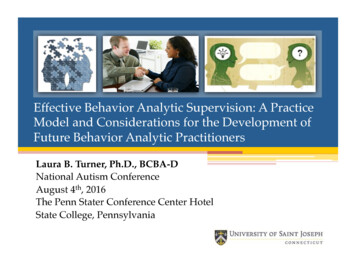
Transcription
Effective Behavior Analytic Supervision: A PracticeModel and Considerations for the Development ofFuture Behavior Analytic PractitionersLaura B. Turner, Ph.D., BCBA-DNational Autism ConferenceAugust 4th, 2016The Penn Stater Conference Center HotelState College, Pennsylvania
Learning Objectives Identify components of effective behavior analytic supervisionconsistent with the BACB Supervisor Training Curriculum. Discuss considerations in conducting evidence-based, sociallyvalid and ethical supervision practices in applied settings. Utilize methods to evaluate the acceptability of the procedures,process, outcomes, and effectiveness of supervision.
Purpose of Trainee Supervision Develop, improve, and maintain effective clinical, professional andethical repertoires in supervisees (BACB, 2012) Guide case conceptualization, problem solving, decision making andassistance seeking repertoires (BACB, 2012) Support supervisee wellbeing Instill a culture of ongoing learning, consultation and self-assessment Support the growth and credibility of the field
Support Client Wellbeing, Progress & Outcomes(BACB, 2012) Effectiveness of supervision on client outcomes was not related to the amountof supervision (i.e., increased supervision hours did not dramatically increasethe number of mastered learning objectives) or the size of a supervisor’scaseload. Rather, effectiveness was related to the qualifications of the supervisor (i.e.,BCBA) and years of experience as a clinical supervisor.
Potential Outcomes of Poor Supervision Inadequate client wellbeing, progress, and outcomes Poor performing supervisees with limited or non-generalizablerepertoires Supervisors who do not become effective supervisorsthemselves Obvious egregious and unethical actsBACB Supervisor Training Curriculum, 2012
Loss of Motivation for the Job Burnout Uncharacteristic angry outbursts, apathy,chronic frustration, reduced productivity Research from other fields A positive supervisory alliance can have a positive impact on the supervisee'sfunctioning and wellbeing (Livni, Crowe, & Gonsalvez, 2012) Perceived supervisor support is correlated with reduced therapist burnout (Gibson,Grey, & Hastings, 2009)
Clinical Example 5 Special Education Teachers working in behavior analyticclassrooms at Institute for Child Development (SUNYBinghamton) 4 session Supervisor Training Workshop (Modified from Reid,Parsons & Green, 2011) Focused on the importance of frequent positive, specific andcorrective feedback in supporting trainees Behavioral Skills Training Measured percentage of different types of writtenperformance feedback used with BCaBA trainees before andafter training
Teacher Supervisory Behavior Before & After WorkshopBegins withpositive/empathic“The workshop had a positive effect on me” - 100% agree
Are you receiving enoughfeedback from your supervisor?”Are you receiving enough supportfrom your rkshopPercentage of “Yes” (%)Percentage of “Yes” ��The workshop had a positive effect on the individuals I supervise” - 100% agree
BCaBA Student RetentionSupervisorTraining
Current Context for Supervision Across Disciplines Accountability & protection of clients Licensure/certification requirements Evidence- and competency-based era – no “osmosis”
Commonalities of Competency BasedSupervision Across Disciplines Assesses outcomes and is rooted in the current literature Utilizes a contract to focus on collaborative approach (e.g., goals,performance criteria, outcomes) Recognizes the importance of a strong supervisory relationship Takes an individualized approach Incorporates frequent performance feedback based on observablebehavior Focuses on self-evaluation and knowledge of own weaknesses
What are our minimal competencies asbehavior analytic supervisors? Development of individualized performance expectations for the superviseeAND supervisor (behavioral contract) Observation, behavioral skills training, and performance feedback Modeling technical, professional and ethical behavior Guiding behavioral case conceptualization, problem-solving, and decisionmaking repertoires Review of written materials (e.g., behavior programs, data sheets) Oversight and evaluation of the effects of service delivery Ongoing evaluation of the effects of supervisionBACB Supervisor Training Curriculum, 2012
Setting the Stage for Quality Supervision:Developing the Supervisory Relationship “Rapport” (Carr et al., 1997, Magito McLaughlin & Carr, 2005) The degree to which a supervisor and a trainee are mutual discriminativestimuli for generalized reinforcement (e.g., positive feedback, socialsupport) How? Potential impact on supervision? Mutually agreed upon expectations for supervisionand engagement in behaviors consistent with thoseexpectations. Supervision contract Guideline 5.05 of the Professional & Ethical Compliance Code (BACB, 2014)
Time Expectations 1 supervisee, accruing 30 hrs.wk of experience hrs In-vivo observation/supervision 30 min. Supervision Meeting 1 hr. Read article/find resources for supervisee 1 hr. Answer questions/respond to emails 15 min. Complete documentation/supervisee evaluation 15 min. Total time 3 hrs. per week How many supervisees can you competently supervise at atime?
Setting the Stage for Quality Supervision:Defining the Relationship The supervisory relationship can be complex teacher,mentor, evaluator, facilitator of self-assessment andgrowth Define the relationship & clarify role expectations Dual relationships Ask about previous supervision experiences(in or outside of behavior analysis) Reciprocal performance feedback Consequences of not meeting expectations(for both parties) Terminating supervision
Setting the Stage for Quality Supervision:Reviewing Confidentiality We have a primary obligation to take reasonableprecautions to respect the confidentiality of those withwhom we work, including supervisees (Professional & Ethical ComplianceCode, BACB, 2014; Guideline 2.06) What is confidential information in a supervisoryrelationship? Considerations regarding who can we disclose informationto, and in what contexts?
Assessing Current Abilities Review course syllabi, previous practicasettings and populations Talk with previous supervisors, if givenpermission Systematically review task list (e.g.,Checklist, rating scale, interview) Observation, present scenarios, role play
Developing Individualized Goals Collaborative - What are the supervisee’s short and long-termprofessional goals? Develop goals in a variety of areas: Professional (e.g., consultation and communication skills) Technical (e.g., conduct an FA) Ethical (e.g., consent process) Basic (e.g., develop fluency with terms for exam) Clinical decision making
Developing Individualized Goals Prioritizing and identifying pre-requisite skills Be mindful of ability level per goal or skill area Planning for independence within and across skill areas Use goals to identify appropriate activities, rather than choosingactivities based on their convenience Sample goals
Considerations for Training Effectiveness, efficiency and acceptability (Parsons, Rollyson & Reid, 2012) Behavioral Skills Training Do you have to use BST all the time? Depends on the skill and the BL ability of the staff (e.g., Graff & Karsten,2012) Role play or in-vivo? In-person modeling or video modeling?
Considerations for Training Assess application and generalization of skills to new targets, clients,and settings (BACB Supervision Training Curriculum, 2012; Stokes & Baer, 1977) Program common stimuli - role play in the location with stimuli Train sufficient exemplars Supervisees are encouraged to have multiple experiences (i.e.,sites, populations “Teach Loosely” - vary noncritical aspects of your teaching
Teach Decision Making via Problem SolvingActivities Utilize structured problem solving activities Define the problem/question Generate alternative solutionsChoose a solution: Cost-benefit analysesImplement the solutionEvaluate outcomes of the solution Ethics Model ethical behavior and openly discuss anyincorrect models APBA ethics challenges
Giving Performance Feedback Performance feedback is an effective procedure for increasing and maintaining skills(Mortenson & Witt, 1998; Reinke et al., 2014) most effective when combined with review of data, goalsetting, antecedents and consequences (Balacazar, 1985, 1986; Noell et al., 2002;Sanetti, Luiselli & Handler, 2007; Neubert, 1998; Alvero et al., 2001; Alvero et al., 2001) most effective when delivered by a supervisor (Balacazar, 1985, 1986) crucial during skill acquisition (Daniels & Bailey, 2014)
Giving Performance Feedback Frequent, Immediate, Descriptive, Positive, Corrective
Catch Supervisee’s Being Good Deliver as frequently and asimmediately as possible,especially in the beginning 4:1 ratio Quick Activity: Thinkabout someone you couldhave given positivefeedback to today, butdidn’t - why didn’t you?What stopped you?
Descriptive Positive Feedback There are “101 ways to say good job” But what did they do that was so good? WHY does it matter (i.e., provide a rationale) Consider linking your feedback to their goals (when appropriate) E.g., “Very impressive performance today with Johnny. Even thoughit was a stressful situation, you followed his plan to the tee. The greatthing was that all the other staff saw you keep your cool andimplement the intervention, which is important as you’re trying toestablish yourself as a role-model. The more you can get in there andmodel, just like you did today, the more the staff will look to you as aleader.”
Using Video & Graphic Feedback Review with supervisee; lends credibility to the feedback Self assessment: Have them watch it back and identify theirown areas of strength and weakness
Individualizing theExperience SupervisionForm if NeededSee BACB Standards for requiredcomponents of the form
Giving Corrective FeedbackSteps BACB Supervisor Training Curriculum, 2012Provide an empathic statement - think about their contextDescribe ineffective performanceProvide a rationale for desired change in performanceProvide instructions and demonstrations for how to improvedesignated performanceProvide opportunities to practice the desired performanceProvide immediate descriptive feedbackA few initial considerationsDon’t correct in publicGive corrective before next performance (response prompt)
Example “Hi ! I’m so glad I got to see you working with Johnny thismorning. I was impressed by how well you remained neutralwhile he was flopped on the ground. That can be a frustratingsituation especially when you feel like you there’s not much youcan do. To avoid this situation all together, let’s talk about a wayto ease the transition and prevent him from flopping in the firstplace. Rather than asking him to line up at the door when he’sengaged in an independent activity, one thing the BIP says to dois ask him to complete tasks he usually complies with beforegiving him the direction to walk to the door to line up (i.e., a taskdemand he usually doesn’t comply with). For example, givinghigh fives and picking up materials from his work area. The pointof this is to gain compliance and spark responding. Let me showyou quick and then I’ll have you show me.
Scenario Your supervisee is going to meet with her client’s parent todevelop a home behavior plan. You have been supervising thesupervisee for nearly a year, but this is her first time workingdirectly with parents. You’ve had her sit in on one of your parentmeetings and you’ve role played several aspects of meeting withparents. She seemed nervous, so you decided to sit in on themeeting with her, but let her take the lead. During the meeting,the supervisee did a nice job establishing rapport with the parent;however, the supervisee often used behavior analytic jargon anddid not notice that the parent was clearly confused. Thesupervisee was also quite directive with the parent, not makingthe process collaborative. You had to jump in several times toclarify and assess the feasibility and acceptability of the proposedplan.
Giving corrective feedback is less preferredthan giving positive feedback Cantillon & Sargeant (2008)
What behaviors do we typically give feedback on? Implementation of assessment and intervention procedures Written materials (e.g., assessment reports, objectives, behaviorplans) Data sheets & graphs Ability to conceptualize a case, problem solve and think critically Ethical behavior Professional behavior
A few examples – what else? Social skills broadlyHow do we define and measure these Assertivenessbehaviors so that we can providefeedback and monitor performance? Appearance Argumentative Empathy and sensitivity to others Tone & nonverbal communication (e.g., facialexpressions) Flexibility/rigidity
Giving Corrective Feedback Research from other fields suggests: Can be most challenging when personal, often subjective, issues areinterfering with the quality of their professional activities (Dittman-Tracy, 2006) Research suggests that supervisors often withhold negativereactions to supervisee’s clinical and professionalperformance, and regret it later (Hoffman et al., 2005) About 47% of supervisors agreed that they gave higherratings to supervisees in fear of harming rapport (Gonsalvez & Freestone,2007) Not raising important feedback can have negativeimplications for clinical work and the supervisoryrelationship (Dittman-Tracy, 2006)
Considerations in Giving Corrective Feedback Is the behavior you are correcting “interfering”? – what is“interfering”? Recognition that professional behavior and expectations can beimpacted by personal factors, such as beliefs, values, andinterpersonal biases and conflicts (BACB ethical code) Potential negative effects on supervisory relationship Recognize it, discuss it and attempt to resolve it. If given poorly, negative supervisory experiences can producesignificant and adverse effects on an individuals future career goals(Ramos-Sanchez et al., 2002) “They did everything wrong” – the importance of prioritizing Be as objective as possible
Being objective can be hard sometimes Will you be objective? Don’t provide corrective feedback when in a bad mood! The longer you wait the harder this can be “Favorites” (The potential negative side effect of strongrapport) Has the potential to overshadow difficulties of ormistakes made by the supervisee. You may get uncomfortable Take time to plan/practice What do you want to get across – what is yourdesired impact?
Use Self-Monitoring & Self-Evaluation Get the supervisee to noticefor themselves Provide prompts forvarious technical andprofessional behaviors andhave them rate variousaspects of theirperformance Use video comparisons Their behavior Model of expected behavior
ExampleYou have received several comments from others regarding howunfriendly one of your supervisees is. For example, she oftenignores others in the hallway and has been described asunapproachable by teacher’s aides. You have also observed thesupervisee often looking “mad” or “uninterested”; however, thesupervisee is always on time, completes all assignments, takesfeedback well and states that she wants to remain in this field andenjoys her job.
Difficult Supervisees1.2.3.4.Argumentative https://www.youtube.com/watch?v gOKWJAvjD4YReluctant https://www.youtube.com/watch?v wfWvWDymehYAttraction https://www.youtube.com/watch?v y-X7JT3NkDYNo Direction https://www.youtube.com/watch?v SxXPqLbrYWo
Documenting Corrective Feedback E,g., dates/times and details of events, feedback given inregard to difficulty areas, responses and reactions fromsupervisee Develop and document a remedial plan with clear specificationof the responsibilities of each party Consultation Reference the supervision contract
Monitoring your Supervisory Behaviors Are you consistently meeting the performance requirements ofa supervisor? Utilize objective and subjective measures Supervisee making progress on goals? Clients making progress? Acceptability of supervision process Supervisee feedback helps serve as a form of self-evaluation to maintaincontinuing education Ethical Consideration: The supervisor is always in the more powerfulposition
Turner, Fisher & Luiselli, 2016
Turner, Fisher & Luiselli, 2016
Turner, Fisher & Luiselli, 2016
Turner, Fisher & Luiselli, 2016
Maintaining Competence is Key to Being aStrong Supervisor “Competence is not static, but is a progression toward everevolving expertise” (Dreyfus and Dreyfus, 1986), requiring continuingassessment of competence across one’s career (Roberts et al., 2005)Model for supervisees; encourage the same practicesMultiple areas of competence, including competency insupervisionRecognition of the influence of your personal stressors on thequality of the supervisory alliance and your own competenceRecognition of your own strengths and weaknesses Recognizing that a strength in one context can be a weakness in another
Come up with a plan and stick with it! Start journal clubs; invite supervisees to join or starttheir own with peers Start supervisory review groups with colleagues Invite peer observers - “Supervision of supervision” Regular conference attendance Go to presentations on content you are not as familiar with Go to presentations on content your supervisee is interested inUse this time to consult with experts - join roundtables Stay up to date with relevant legal and professional issues Join email lists of professional organizations
Three questions to leave you with. What are your strengths and weaknesses as a supervisor? How are you monitoring the effectiveness andacceptability of your supervisory behavior? Who do you regularly consult with regardingsupervision issues?
lbturner@usj.edu
to ease the transition and prevent him from flopping in the first place. Rather than asking him to line up at the door when he’s engaged in an independent activity, one thing the BIP says to do is ask him to complete tasks he usually complies with before giving him t
